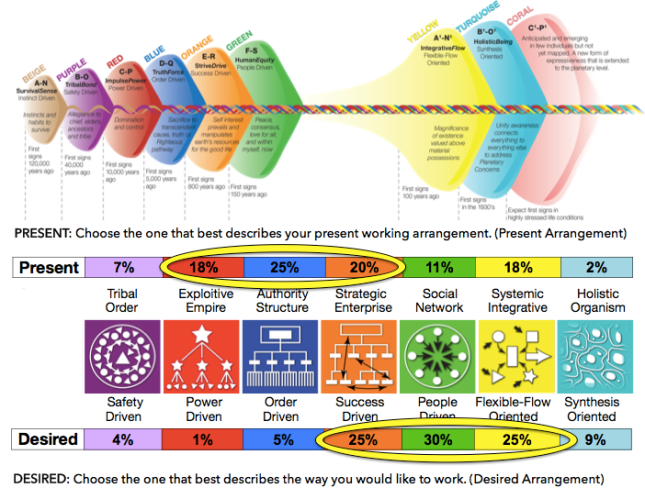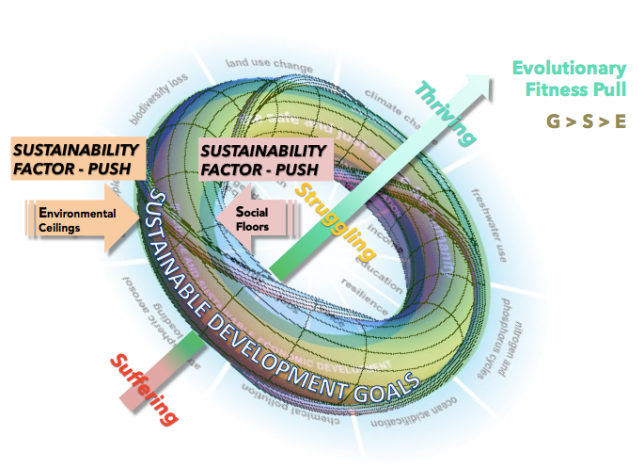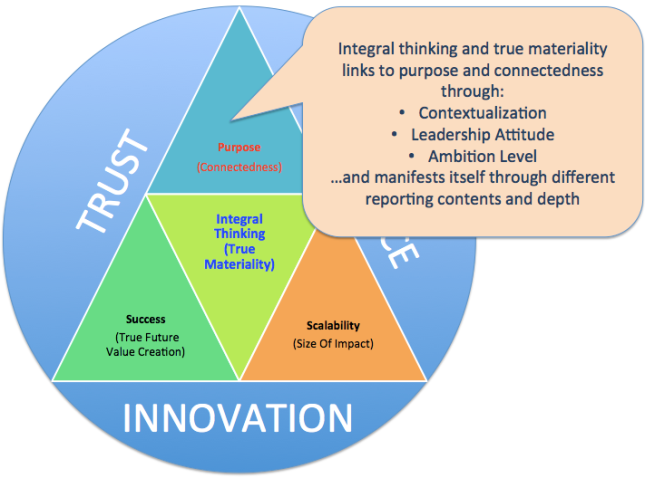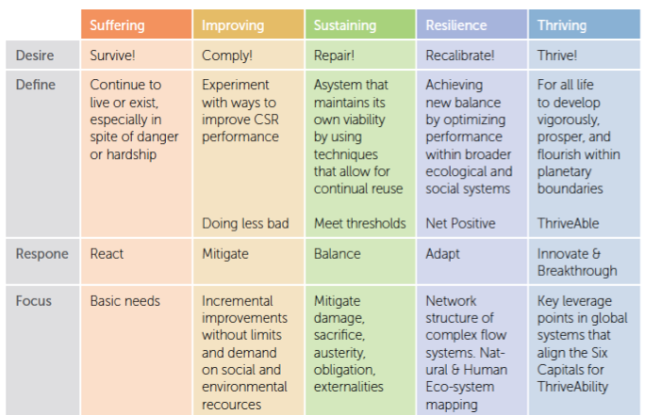This 7-part series has been first published on Sustainable Brands between late January and early March 2016 as a 6-part series and a follow-up by Bill Baue, co-founder of Convetit and the Sustainability Context Group. It captures the essence of my thinking I was able to gather through the extraordinary work of the Reporting 3.0 Platform, GISR and the ThriveAbility Foundation in 2015. What came out is a structure that I called a ‘new impetus embracing purpose, success and scalability for thriving organizations’. I am reposting the original 6 parts here and add a part #7 with reflections of others. This is part 5/7.
Here in Part 5 of the series, we look at the lower-right third of the new impetus diagram that we introduced in Part 1. We have already built a great basis through the discussion about purpose of the organization, how that links to support a green & inclusive and/or regenerative economy concept (Part 3). We also have more clarity on how organizations calculate success through multi-capital accounting and assess True Future Value potential (Part 4). The tools used don’t have to be perfect already, as long as they are decision-useful and are good enough to prepare decision-making by the relevant bodies. Take, for example, Puma’s first e-p/l or The Crown Estate’s Total Contribution concept as good examples of decision-useful concepts that readily admitted their room to continue maturing.
So this Part will focus on activities needed to scale up a green and inclusive economy from within the organization and externally. And as the below diagram suggests, scalability ties directly into purpose and success.

Diagram 8: Integral thinking and true materiality need a renewed focus on scalability and the necessary size of the impacts to be achieved for the green & inclusive economy we desire.
Overcoming the 3-gap problem internally
Internally, the challenge is to create the necessary socio-cultural leadership atmosphere that creates the understanding of the organizational transformation capacity that allows sustainability to be fully embedded, up to the potential ambition level of being a thrivable organization (as per the strategy continuum presented in Part 3, Diagram 4) and as presented through the 3-gap-problem in Diagram 2 in Part 2 of the series and the aligned ThriveAbility Index measurement as laid out in Part 4.
The ThriveAbility Foundation based its approach on a ThriveAbility Journey for organizations on the idea of stratification, recognising that people pass through developmental stages at different rate and that their worldview, values and needs vary considerably depending upon their developmental Center of Gravity i.e. where they are most comfortable and capable. This means that:
- in our communications and interactions with others, we are most likely to be effective when we meet people where they are at;
- when designing change and transformation initiatives, surveys of the developmental levels of people in the organisation are essential to map the alignment of individuals with the organisation and each other, as well as the changes proposed;
- motivating people needs to take a stratified approach, while also identifying where the energy for change is coming from, and where the blockages to change arise*.
Various techniques advance this approach. At the ThriveAbility Foundation, we use CultureView and LeaderView assessments to build the basis for an organizational stratification approach**. This approach stems from more than 40 years of learning about Spiral Dynamics and Integral Theory, now also designed to fit the ThriveAbility strategy continuum. The below diagram shows a sample of a Masterclass of executives that was able to learn
- the various levels of the emergence of human consciousness as it has been mapped by Integral Theory. It is the story of a dynamic interplay of human coping mechanisms that leave behind observable patterns in ‘bio-psycho-cultural-social systems’;
- how the individual emergence level of the group participants is composed of;
- how the sum of the individual levels constitute the governance, hierarchy and work processes of the organization;
- how their present working state differs from their desired working state that allows organizational transformation and the necessary purpose and success discussions and decisions to become focus areas for the organization to prepare for that change.

Diagram 9: Building organizational awareness about present and desired work arrangements through a cultural and leadership lens.
The group also learned about their readiness for change, their change patterns and their executive change intelligence, as well as their patterns of thinking, coping mechanisms, perception of organizational priorities and finally an overall cultural fit-factor. If a total change of mindset is necessary, it will need to happen here.
To measure progress toward ThriveAbility across the 3 Gaps, the ThriveAbility Foundation can utilize:
- CultureView and LeaderView, which assess progress on the Socio-Cultural Leadership Axis;
- The ThriveAbility Maturity Assessment, which covers about 90 specific criteria and related variables to measure scaling up on the Organizational Transformation Axis;
- The Multi-Capital Scorecard (MCS), a context-based measurement tool successfully employed at Cabot Creamery Cooperative, Unilever subsidiary Ben & Jerry’s, and Procter & Gamble Subsidiary New Chapter to assess progress on closing the Sustainability Axis, as well as the Future Fit Business Benchmark (FFBB), which offers a set of 21 science-based indicators (to be published in spring 2016), employed e.g. at The Body Shop.
Combining all these tools will help to transform Kate Raworth’s 2-dimensional Doughnut, which defines the environmental ceilings and social floors to achieve a safe and just operating space for humankind, into a 3-dimensional change management tool that describes how companies can support the shift from suffering to struggling to thriving by activating innovation pathways. This would build the core roadmap design for an organization that attends to micro-macro connections while creating business benefit and measuring programs and activities in a multi-capital way. Building a connection to the SDGs now also makes more sense as they are seen in a seamless and clearly positioned manner. It would also lead to a strengthened role of governance, best described from moving from an ESG push to a GSE pull (as described in Part 3 already), a change of mindset of governance experts is needed.

Diagram 10: Designing Innovation Pathways that helps organizations connect a clearer purpose, success definition and scalability potential to their ThriveAbility approaches (Source: ThriveAbility Foundation, based on Kate Raworth’s Doughnut).
In addition to these tools, scenario planning and business modeling are important tools, too. Building on Osterwalder’s Business Model Canvas, the Flourishing Business Model Canvas is a welcome broadening of Osterwalder’s model, but still in an experimentation phase.
While the stratification approach is mainly educational for designing and deciding on strategic priorities, the second main aspect to prepare for scalability is collaboration. While current conventional wisdom embraces Integrated Thinking, the ThriveAbility Foundation advocates the deeper approach of Integral Thinking, which embraces Integral Theory to dig deeper and combine all dimensions of the 3-gap-problem.
It is reassuring to see how organizations that deal with these three gaps at the same time develop the best potential to become thrivable organizations. A shining example is Interface, one of the leading carpet-tile companies, showcasing the success potential of becoming what they call a ‘restorative’ business. Over the last 22 years the company has worked on their ‘Mission Zero’, climbing ‘Mount Sustainability’ and developing business models like ‘NetWorks’ to succeed on an fully embedded Circular Economy approach and Biomimicry strategy by 2020, while building additional social value. ‘NetWorks’, developed with the Zoological Society of London (ZSL), stems from that thinking. Other organizations that come to mind that show potential in closing the 3 gaps simultaneously are Kingfisher, The Crown Estate, Natura, Unilever, BT, The Body Shop, Patagonia, with many other organizations still some steps away.
The problem, however, is that for those companies that still need to follow suite 22 years later, the path is way too long. So the work of Reporting 3.0, The ThriveAbility Foundation, and GISR are all essential pieces to get this enlightenment pathway down to 5-10 years, so scaling up successes through education and collaboration is essential.
Overcoming the 3-gap problem externally
Collaboration and education of course also have an external side. Programs could be envisaged for industry associations and specific networks that are playing an important role in issue-specific leverage on many fronts. They can use the same instruments as companies use internally, and can hugely benefit from them. Analyzing many of the existing networks from the 3-gap-problem perspective, most of them deal with one or two axis, hardly anyone pushes for all three. The above portfolio is an offering to learn and fill the blanks through education for such groups and additional stimulation for collaboration.
At this time it is crucial to insist on one specific point that also closes the circle to the discussion around purpose and success definition. We have already discussed the economic system aspect in the earlier Parts, especially around the ‚micro-macro-link’. To put it bluntly again: without a generic change in our economic system boundaries that define costing, pricing and taxing of resources and activities, there won’t be ThriveAbility, let alone sustainability. We will have to rely on the 5-10% of enlightened leaders that will help to make the remaining 90% become brave followers through a changed economic system with a level playing field that will need to demand playing by the changed rules. That means that advocation of existing leaders towards such a change in the economic system boundaries becomes a crucial aspect in scalability to turn our planetary ship around, or even more: it becomes a matter of survival.
We saw glimpses of that potential willingness for advocation in the cases of the SDGs and COP21, but we also see specific not-for-profit organizations ready to start for that advocation through their very own purpose, too. Ex’tax, a Dutch NGO, is specifically advocating for the taxation system to change to resource taxation instead of taxation on labour. The True Price Foundation advocates for a better inclusion of external costing in pricing structures. Other initiatives like Trucost, The Natural Capital Coalition, the Science-Based Targets Initiative (and many more), help define other parts of the advocation spectrum and link micro through meso to macro. These initiatives tackle the heart of economic system boundary change, they go further than just the SDGs that don’t imagine a changed economic system.
What to do in the short term?
Let’s imagine once more what a sustainability and/or integrated report could already report on for the scalability part of our new impetus. Innovation roadmaps, transformational change, stratification as laid out in this part of the series will take a while to become customized, fine-tuned and carried out. But here’s what could be reported on in this coming reporting cycle already:
Education (internal and external):
- How far are the ‘World View’, the ambition level and the related strategy communicated within the organization, and how do education/training programs consider and support this?
- Are all employees addressed and is this completely integrated in education and training on all levels of the organization?
- Are there joint educational programs developed for the whole value cycle (in consequence: internally and externally) and does this support joint target-setting and implementation campaigns to achieve sustainability/ThriveAbility in these value cycles?
Collaboration Capabilities:
- In how far is the company engaged beyond its associations and interest lobbying? Which networks, cross-industry initiatives to create new sustainable business models for societal value added is the company part of? Do those need to be created still by a group of companies?
- Do employees have time for societal engagement and are they positively stimulated to help find long-term solutions in order to avoid short-term conflict? Is there slack time to ‘think’ alone, in groups, on all three parts of this new impetus?
- Is the company aware and busy with true sustainable innovation beyond existing rebound effects, e.g. in creating circular, sharing or collaborative service business models?
- In which thematic research networks is the company active? Does it take part in award schemes on most sustainable solutions, alone or together with other partners?
Advocation:
- Is the company perceived as an active player in presenting their ‘World View’ and their potential scenarios around sustainability and/or ThriveAbility?
- Is the leadership actively engaged in the promotion of a green & inclusive economy and the necessary changes in boundary setting, e.g. internalization of external costs, changes towards a more sustainable tax system, creating of level playing fields in international relations, e.g. trade agreements, international accounting rules, etc.)
With Parts 3, 4 and 5 we have now covered all three parts of the triangle that surround the idea of Integral Thinking and True Materiality. With the instruments in place, the processes to be adapted, and the people lined up towards purpose, success and scalability, the new impetus should create necessary outcomes to become a useful framework for designing a multi-year roadmap. By that, all current initiatives an organization carries out can be put in place, assessed and positioned.
In Part 6 we will look at the envisaged outcomes of the new impetus. It will be the closing Part of this series.
* Thanks go to Dr. Robin Lincoln Wood for crafting the ‚stratification’ definition for the purpose of achieving ThriveAbility.
** Culture View and Leadership View have been developed by 5Deep Ltd. and have been adapted to help closing the 3-gap-problem for ThriveAbility. These are standard instruments in masterclasses and corporate transformation projects for ThriveAbility.
 Diagram 3: Integral thinking and true materiality need a renewed focus on the purpose of the organization and connectedness to the economy we want to live in.
Diagram 3: Integral thinking and true materiality need a renewed focus on the purpose of the organization and connectedness to the economy we want to live in. Diagram 4: The strategy continuum to assess a company’s position in a world that needs to leapfrog from surviving to thriving (Source: A Leader’s Guide to ThriveAbility, page 18).
Diagram 4: The strategy continuum to assess a company’s position in a world that needs to leapfrog from surviving to thriving (Source: A Leader’s Guide to ThriveAbility, page 18).